Space is Flexible (and Full of Light)
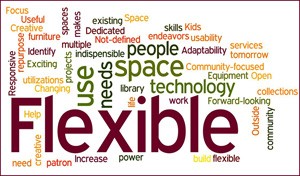
Library space, that is. If there is one word that sums up the re-imagination of library space for community engagement in the digital age, it is flexible.
The tension between physical and virtual space surfaces everywhere as technology increasingly permeates our lives. As this tension plays out in libraries, contradictions arise. Libraries are still seen by the general public as repositories of books, yet patrons make increasing use of the electronic collections. Libraries are traditionally rock-solid physical community spaces. Now patrons visit the library increasingly on the virtual front, engaging in online services and interactions; yet they still walk through the doors in healthy numbers to enjoy the physical space. It’s not an either-or choice. Libraries are at a juncture, bursting with potential for a powerful union of physical space with digital technologies. Ensuring flexibility in the physical space is instrumental to catalyzing the marriage.
When asked what words come to mind for “innovative library spaces,” participants in the Flexible Spaces – Flexible Futures webinar flooded the chat with enthusiastic responses, echoing this word cloud. Flexible appeared frequently, interspersed with allusions to enabling creativity (creative space, collaboration, experimentation, thinking spaces) through technology (technology enhanced, adaptable to future-tech, iPad room, digital whiteboard). If this audience of 500 is at all representative of the library field, then the vision is ripe with people eager to meld space and technology through the flexibility of being able to reconfigure space as needs of the community evolve over time, and even over the course of a day. The webinar offers suggestions on how to get started and explore the frontiers of library space reinvented.
As Facilities Design Coordinator for King County Library System (KCLS), Dri Ralph has helped lead the entire system through an extensive bond project, completing the renovation and/or building of 30 libraries, with 15 more to do. With the $172m bond passed in 2004, KCLS has had the luxury of conceiving modern, light-filled, well-wired, multi-use structures in high visibility locations. While the majority of libraries are far from having such an opportunity, the KCLS design strategies can be applied on many levels of budget and capacity.
1. Space is Elastic
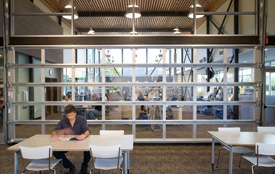 In any library, there is a lot going on during a typical week. The temptation is to designate a fixed space for each activity, and either lobby for a larger building or shoehorn various functions into small spaces. There is a better way—multi-use space. The eye-opener for KCLS came from community input for the design of the Covington branch. It’s located in an isolated area where the residents depend on the library for meeting space. They wanted a 400-seat meeting room, which would eat up the budget and the square footage… and be empty for significant amounts of time. The solution: create a “great hall” in the main space of the library, where everything is on casters and readily movable. The tables, chairs, and shelves are all easy to roll out of the way to accommodate 400 people for an event.
In any library, there is a lot going on during a typical week. The temptation is to designate a fixed space for each activity, and either lobby for a larger building or shoehorn various functions into small spaces. There is a better way—multi-use space. The eye-opener for KCLS came from community input for the design of the Covington branch. It’s located in an isolated area where the residents depend on the library for meeting space. They wanted a 400-seat meeting room, which would eat up the budget and the square footage… and be empty for significant amounts of time. The solution: create a “great hall” in the main space of the library, where everything is on casters and readily movable. The tables, chairs, and shelves are all easy to roll out of the way to accommodate 400 people for an event.
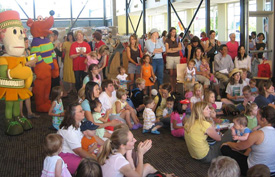 In other branches, they have devised a beautiful and utilitarian solution of sectioning off an area with a glass-paned garage door. The large door creates a quiet but still light-filled space when closed and a generous meeting space when open. The two photos from the Sammamish branch illustrate the dual use of the same space, the dramatic shift from sequestered, individual occupancy to the overflow of attendees at an event.
In other branches, they have devised a beautiful and utilitarian solution of sectioning off an area with a glass-paned garage door. The large door creates a quiet but still light-filled space when closed and a generous meeting space when open. The two photos from the Sammamish branch illustrate the dual use of the same space, the dramatic shift from sequestered, individual occupancy to the overflow of attendees at an event.
Even if you can’t architect a space from the ground up, consider how you could rearrange your current use of floor space to open up a lesser version of the “great hall” concept. Removing barriers between areas has the added benefit of increasing the light in the building. Natural light was a top preference for King County community members. Try to situate the open, multi-use space on the side of your largest window wall. Put everything on wheels.
2. Furniture Rocks and Rolls
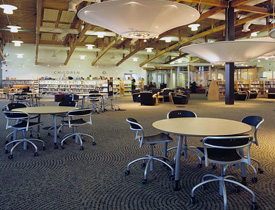 Multi-use space demands movable furniture. And it’s the humble, hard-working caster that contributes to the transformation of space. In addition to putting wheels on everything—chairs, tables, and shelving, furniture is carefully selected for its light weight and easy mobility. Wheeled shelving units will generally be lower profile, which adds to the openness and lightness of the space.
Multi-use space demands movable furniture. And it’s the humble, hard-working caster that contributes to the transformation of space. In addition to putting wheels on everything—chairs, tables, and shelving, furniture is carefully selected for its light weight and easy mobility. Wheeled shelving units will generally be lower profile, which adds to the openness and lightness of the space.
It’s not only the staff who will be moving furniture around. In KCLS libraries, patrons are invited to regroup tables and chairs to fit their desired use of the space. For maximum possibilities of recombination, Dri has chosen 2- or 4-person tables, which are easy to mix and reconfigure. An active day in the library finds a mix of individuals or couples at small tables and groups of various sizes who have pulled table together for conversation and exploration. In this digital age, much activity involves electronic devices and Internet connections. To avoid the proclivity to cluster around available electrical and data outlets, the infrastructure design has dispersed those throughout the spaces. Abundant wiring for a wired world is pivotal to the intersection of physical and virtual space.
For some, the idea of patrons moving furniture around is discomforting. Dri embraces the idea; “I feel really great about it; do it as much as you want!” It goes along with the evolution of the library from quiet cloister to lively, noisy and active space. For those who desire quiet reflective space, KCLS includes a quiet study room in all their libraries.
3. Patrons Find the Path
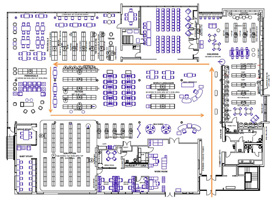 By studying how patrons walk through a library space, KCLS learned that most patrons avoid contact with staff, preferring to find their own way as if on a self-guided walking tour. The floor plan should enhance that tendency rather than fight it by providing a clear “patron path.” If visitors walk in the door and are confronted with a maze of desks and stacks, they may feel forced to approach the information desk to ask directions. A good patron path layout has a welcoming entry point that guides the visitor toward a natural navigation around the floor, enabling exploration and discovery on their own. A wayfinding scheme provides cues along the path, with clear signage to mark key points of interest. Based on research showing that their patrons visit an average of 5-7 branches, KCLS uses a consistent signage design across their branches; it helps people orient easily to different buildings and layouts.
By studying how patrons walk through a library space, KCLS learned that most patrons avoid contact with staff, preferring to find their own way as if on a self-guided walking tour. The floor plan should enhance that tendency rather than fight it by providing a clear “patron path.” If visitors walk in the door and are confronted with a maze of desks and stacks, they may feel forced to approach the information desk to ask directions. A good patron path layout has a welcoming entry point that guides the visitor toward a natural navigation around the floor, enabling exploration and discovery on their own. A wayfinding scheme provides cues along the path, with clear signage to mark key points of interest. Based on research showing that their patrons visit an average of 5-7 branches, KCLS uses a consistent signage design across their branches; it helps people orient easily to different buildings and layouts.
The clear path and the multi-use spaces with movable furniture would seem to be in conflict. Dri is a strong advocate of restoring order to the furniture arrangement daily, at least very regularly. It “resets the path” and maintains patrons’ sense of familiarity with the space.
4. Collections are Slender and Modern
If you’re not doubling your space by building new or renovating, where do you make room for multi-use space? Take an objective look at the amount of space occupied by your collections and think about doing some aggressive weeding. KCLS tracking has revealed counterintuitive data, which indicates that when collections are reduced significantly, circulation actually increases. They recommend a formula of five items per square foot. De-cluttering the collection focuses the resources, makes items more findable and allows more space for the kinds of programming that the community enjoys.
With the rise of electronic collections, there is a trend toward the bookless library. KCLS has a much richer solution—the integration of print and electronic materials. New shelving units combine displays of print materials with a touch screen, with power and data connections embedded in the structure for patrons to plug in multiple ways. The electronic interface promotes the e-collection and the print collection, giving the patron a deeper view into their possible choices of format.
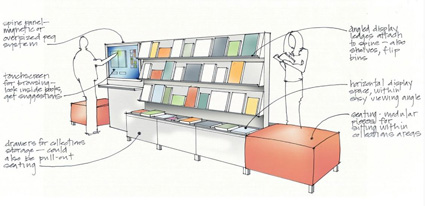
For more ideas, inspiration, and images of the light-filled libraries of King County, watch the archive. WebJunction will be looking further into the transformation of library spaces in future articles. In the meantime, let us know what you’re doing to flex your space, especially if it’s on a small scale.
